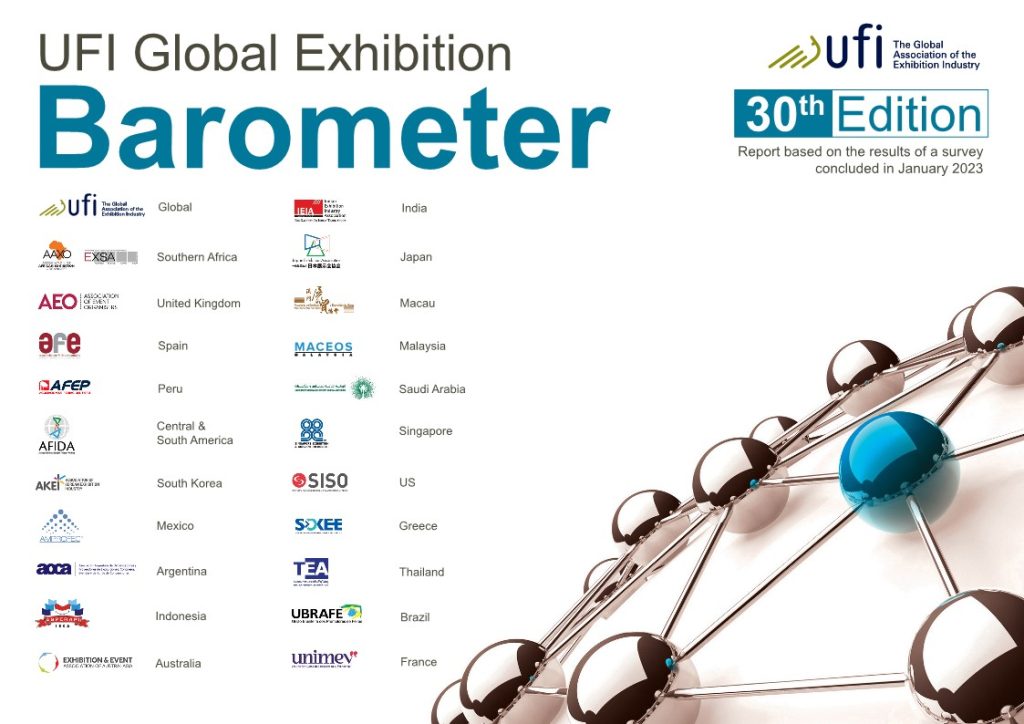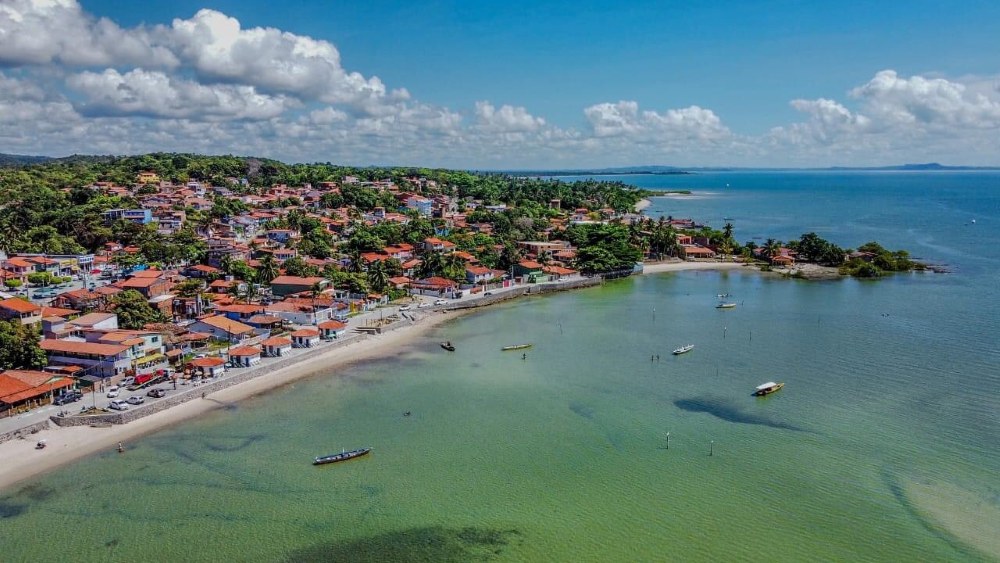L’UFI (The Global Association of the Exhibition Industry), l’Association mondiale du secteur des expositions, a publié la dernière et 30e édition de son étude phare, le Baromètre mondial des expositions, qui prend le pouls du secteur.
Les résultats soulignent l’accélération de la reprise de l’industrie en 2022 et des perspectives positives pour 2023.
Bien qu’il y ait des preuves solides que la pandémie de COVID-19 soit désormais surmontée par la plupart des marchés, la reprise complète est attendue en 2023, car il reste quelques marchés, dont la Chine, où cette reprise n’est pas encore prévue pour cette année. Au niveau mondial, les opérations continuent de s’améliorer, la proportion d’entreprises déclarant une ” activité normale ” passant progressivement de 30 % en janvier 2022 à 72 % en décembre 2022, devrait atteindre 80 % en juin 2023 – s’alignant ainsi sur les niveaux pré-pandémiques.
Les entreprises de la plupart des marchés prévoient de livrer des résultats 2022 proches de leurs niveaux de 2019. En termes de bénéfice d’exploitation, environ la moitié des entreprises déclarent une augmentation ou un niveau stable pour 2022 par rapport aux niveaux de 2019 et passant à 7 sur 10 pour 2023. Ces résultats pour 2022 ont été obtenus sans aucune aide financière publique pour 69 % des entreprises, et pour la moitié de celles qui l’ont fait, cette aide a représenté moins de 10 % de leurs coûts globaux.
Les problèmes commerciaux les plus urgents reflètent également la façon dont le secteur se concentre désormais sur les défis et les opportunités post-pandémie : ” Défis de gestion interne ” (mis en avant par 20 % des répondants), ” Impact de la numérisation ” (16 %), ” État de l’économie sur le marché national ” et ” Évolution de l’économie mondiale ” (15 % des réponses chacun) sont les plus courants. En comparaison, l'”Impact de la pandémie COVID-19 sur l’entreprise” n’est désormais marqué par que 5% des entreprises comme l’un des problèmes les plus importants (contre 19% il y a douze mois).
« Nous pouvons arrêter de nous focaliser sur la “reprise post-pandémie” et passer à autre chose ! Cette 30e édition de notre Baromètre confirme que la phase de reprise se termine dans la plupart des marchés du monde. Si chaque marché présente certaines spécificités, l’attention s’est globalement déplacée vers les défis futurs. La gestion interne – principalement le recrutement – et la nécessité de poursuivre le développement de la numérisation sont des préoccupations majeures dans le monde entier », déclare Kai Hattendorf, directeur général et PDG de l’UFI.
Taille et portée
Cette dernière édition de l’enquête semestrielle de l’UFI sur le secteur a été terminée en janvier 2023 et comprend les données de 367 entreprises dans 56 pays et régions.
L’étude comprend également des perspectives et des analyses pour 21 pays et régions cibles – Argentine, Australie, Brésil, Chili, Chine, Colombie, France, Allemagne, Grèce, Inde, Italie, Malaisie, Mexique, Arabie saoudite, Afrique du Sud, Espagne, Thaïlande, Turquie, EAU, Royaume-Uni et États-Unis – ainsi que cinq zones régionales agrégées supplémentaires.
Opérations
Les niveaux les plus élevés d'”activité normale” pour le premier semestre 2023 sont attendus en moyenne au Brésil (98%), en Turquie et aux États-Unis (95%), au Royaume-Uni (90%), en Italie et en Thaïlande (88%), et en Espagne et aux Émirats arabes unis (85%). En Chine, seuls 29% s’attendent à une activité normale, et 40% à une activité réduite.
Ces perspectives globalement très positives s’expliquent par le fait que les salons peuvent désormais être organisés partout dans le monde, sauf dans certains endroits en Chine. Parallèlement, de nouvelles mesures d’hygiène sont signalées dans plusieurs régions (dans plus de 20% des réponses en Malaisie, Arabie saoudite et Thaïlande). Rien qu’en Chine, en décembre 2022, et en combinant tous les marchés, 55% des répondants ont déclaré que les expositions pouvaient être organisées (généralement avec des mesures d’hygiène), 17% ont indiqué que “seuls les événements locaux” l’étaient et 28% ont déclaré que les événements n’étaient toujours pas autorisés.
Les organisateurs de salons participant à cette édition du Baromètre ont également été invités à évaluer les formules “acheteurs hébergés”, par lesquelles l’organisateur invite et héberge des visiteurs sélectionnés en échange d’un nombre garanti de rendez-vous d’affaires avec les entreprises exposantes.
Les résultats globaux indiquent que la moitié des répondants appliquent ce concept et, si un sur quatre est satisfait de ces programmes, deux tiers déclarent avoir des résultats mitigés. Les résultats varient considérablement d’un marché à l’autre, ce qui permet de mieux comprendre les possibilités offertes par les programmes d’acheteurs hébergés.
Chiffre d’affaires, bénéfices d’exploitation et soutien financier public
Au niveau mondial, en moyenne et hors Chine, les revenus pour 2022 et 2023 représentent et 94 % des niveaux de 2019.
La Colombie, la France, l’Arabie saoudite, l’Espagne et la Turquie ont obtenu des résultats bien supérieurs à cette moyenne en 2022 et le Royaume-Uni rejoindra ce groupe en 2023.
À l’échelle mondiale, 4 % des répondants prévoient une perte pour 2023, contre 11 % pour 2022. La plus forte proportion d’entreprises prévoyant une perte en 2023 est déclarée en Chine (18%), en Allemagne (17%) et en Italie (11%).
Si les proportions les plus élevées d’entreprises bénéficiant d’un soutien financier public sont identifiées en Europe et en Asie-Pacifique, il existe des différences significatives entre tous les marchés régionaux, et les pourcentages d’entreprises déclarant n’avoir reçu “aucune aide publique” varient :
- de 69% aux États-Unis à 100% au Mexique, pour l’Amérique du Nord
- de 53% au Brésil à 83% au Chili, pour l’Amérique centrale et du Sud
- de 12 % en Grèce à 86 % au Royaume-Uni, pour l’Europe
- de 67 % en Arabie saoudite à 91 % dans les Émirats arabes unis, pour le Moyen-Orient et l’Afrique
- de 19% en Malaisie à 100% en Inde, pour l’Asie-Pacifique.
À l’occasion de la 30e édition du Baromètre, un examen spécial des tendances a été entrepris pour montrer comment les priorités de l’industrie ont changé ces dernières années. L’analyse de la tendance autour des principaux enjeux commerciaux sur la période 2015-2022 identifie plusieurs changements importants :
- “Impact de la numérisation/Concurrence avec d’autres médias” se classe désormais comme le principal enjeu, avec 30 % des réponses (contre 14 % en 2015).
- Les “Développements économiques mondiaux/Etat de l’économie sur le marché national” sont passés de la question principale en 2015 (44% des réponses) à 22% en 2021 et 29% en 2022, tandis que l'”Impact de la pandémie COVID-19 sur l’entreprise” est passé de 29% en 2020 à 5% en 2022.
- Et “Les défis de gestion interne” ont augmenté de 14% en 2015 à 20% en 2022.
Parallèlement, “Durabilité/climat et autres problèmes des parties prenantes” a doublé, passant de 4 % des réponses en 2015 à 8 % en 2022, tandis que “Concurrence au sein du secteur des expositions” a considérablement diminué, passant de 20 % en 2015 à moins de 8 % en 2022.
Les futurs formats d’exposition : événements physiques et numériques
En plus des 88% d’entreprises qui sont convaincues que le “COVID-19 à augmenter la valeur des événements en face à face” :
- 26% (contre 44% et 63% précédemment) pensent qu’il y aura “moins de salons internationaux “physiques” et, globalement, moins de participants” (5% déclarant “Oui, à coup sûr”, 22% déclarant “Très probablement” et 31% restant incertains).
- 57% (contre 73% et 80% précédemment) pensent qu’il y a “une poussée vers des événements hybrides, plus d’éléments numériques dans les événements” (10% déclarant “Oui, certainement”, 47% déclarant “Très probablement” et 25% restant incertains).
- 5% (contre 11% et 14% précédemment) sont d’accord pour dire que “les événements virtuels remplacent les événements physiques”, tandis que 11% ne sont pas sûrs et 84% déclarent “Pas sûr du tout” ou “Définitivement pas”.
Télécharger le rapport complet
La prochaine enquête du Baromètre mondial des expositions de l’UFI sera menée en juin 2023.
Source : UFI








